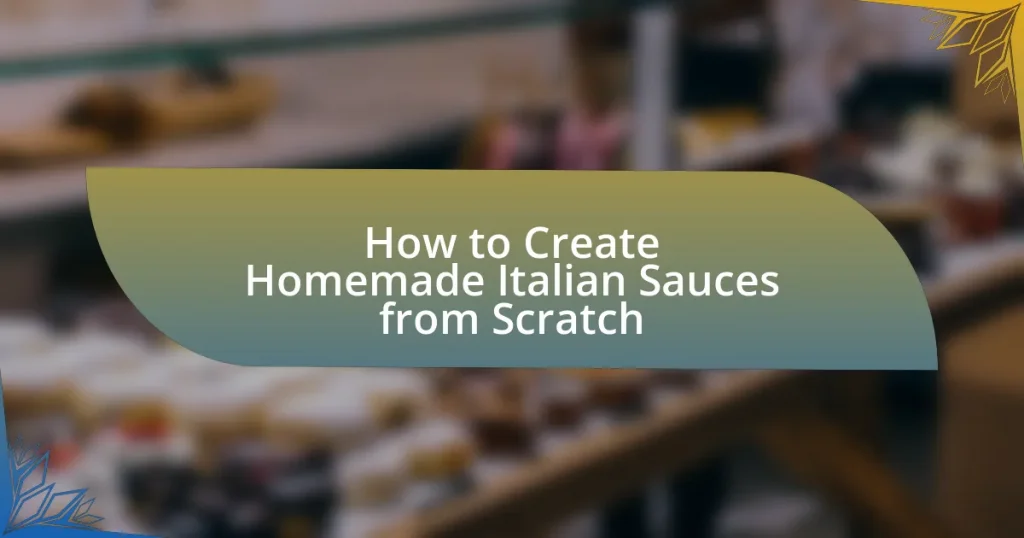The article focuses on creating homemade Italian sauces from scratch, detailing various types such as marinara, pesto, Alfredo, Bolognese, and puttanesca. It explores the differences between traditional and modern variations, highlighting key ingredients and regional influences that shape sauce recipes. The article provides step-by-step instructions for preparing popular sauces, essential tools and techniques, and tips for enhancing flavors and presentation. Additionally, it discusses common mistakes to avoid, storage methods, and creative variations to elevate classic recipes, ensuring a comprehensive guide for anyone looking to master Italian sauce-making.

What are the different types of homemade Italian sauces?
Homemade Italian sauces include marinara, pesto, Alfredo, Bolognese, and puttanesca. Marinara is a tomato-based sauce often seasoned with garlic, onions, and herbs. Pesto is made from fresh basil, garlic, pine nuts, Parmesan cheese, and olive oil, creating a vibrant green sauce. Alfredo is a creamy sauce made with butter, heavy cream, and Parmesan cheese, typically served with fettuccine. Bolognese is a rich meat sauce that combines ground meat, tomatoes, and vegetables, simmered for a long time to develop flavor. Puttanesca features tomatoes, olives, capers, and garlic, offering a bold and savory taste. Each sauce has distinct ingredients and preparation methods, reflecting the diversity of Italian cuisine.
How do traditional Italian sauces differ from modern variations?
Traditional Italian sauces typically emphasize simplicity and the use of fresh, high-quality ingredients, while modern variations often incorporate diverse flavors, techniques, and ingredients influenced by global cuisines. Traditional sauces like marinara and pesto rely on a few core ingredients—such as tomatoes, basil, garlic, and olive oil—prepared with minimal processing to highlight their natural flavors. In contrast, modern variations may include additional spices, cream, or even unconventional ingredients like nuts and fruits, reflecting contemporary culinary trends and fusion cooking. This evolution in sauce preparation is evident in the growing popularity of sauces like vodka sauce or spicy arrabbiata, which blend traditional elements with innovative twists.
What are the key ingredients in classic Italian sauces?
Classic Italian sauces typically include key ingredients such as tomatoes, garlic, olive oil, and fresh herbs. For example, marinara sauce is primarily made from tomatoes, garlic, and basil, while pesto sauce features basil, garlic, pine nuts, Parmesan cheese, and olive oil. These ingredients are foundational in creating the rich flavors characteristic of traditional Italian cuisine, as they have been used for centuries in various regional recipes across Italy.
How do regional differences influence sauce recipes?
Regional differences significantly influence sauce recipes by dictating the choice of ingredients, preparation methods, and flavor profiles. For instance, Northern Italian sauces often incorporate cream and butter, reflecting the region’s dairy farming, while Southern Italian sauces typically use olive oil, tomatoes, and garlic, showcasing the Mediterranean climate and agricultural practices. Historical trade routes and local agricultural products further shape these variations; for example, the use of capers and olives in Sicilian sauces is a result of Arab influence on the island’s cuisine. Thus, regional characteristics directly impact the composition and taste of sauces, making them unique to their origins.
What are the most popular homemade Italian sauces?
The most popular homemade Italian sauces include marinara, pesto, Alfredo, and Bolognese. Marinara sauce, made from tomatoes, garlic, and herbs, is a staple in Italian cuisine, often used with pasta and pizza. Pesto, originating from Genoa, combines basil, garlic, pine nuts, Parmesan cheese, and olive oil, creating a vibrant green sauce ideal for pasta and sandwiches. Alfredo sauce, a creamy blend of butter, heavy cream, and Parmesan cheese, is commonly paired with fettuccine. Bolognese, a rich meat sauce made with ground beef, tomatoes, and vegetables, is traditionally served with tagliatelle. These sauces are foundational in Italian cooking and are widely recognized for their distinct flavors and versatility.
What is the recipe for Marinara sauce?
The recipe for Marinara sauce includes the following ingredients: 2 tablespoons of olive oil, 4 cloves of garlic (minced), 1 can (28 ounces) of crushed tomatoes, 1 teaspoon of dried oregano, 1 teaspoon of salt, and freshly ground black pepper to taste. To prepare the sauce, heat the olive oil in a saucepan over medium heat, add the minced garlic, and sauté until fragrant. Then, add the crushed tomatoes, oregano, salt, and pepper. Simmer the sauce for about 20-30 minutes, stirring occasionally, until it thickens. Marinara sauce is a classic Italian sauce known for its simplicity and rich flavor, often used in pasta dishes and as a base for other sauces.
How is Pesto sauce made from scratch?
Pesto sauce is made from scratch by blending fresh basil leaves, garlic, pine nuts, Parmesan cheese, and olive oil. The process begins with crushing garlic and pine nuts in a mortar and pestle or food processor, followed by adding basil leaves and grinding until a paste forms. Next, grated Parmesan cheese is mixed in, and olive oil is gradually added to achieve the desired consistency. This method is rooted in traditional Italian cuisine, where the balance of ingredients creates a vibrant flavor profile, making pesto a staple in many dishes.
What are the steps to create a Bolognese sauce?
To create a Bolognese sauce, start by finely chopping onions, carrots, and celery, then sauté them in olive oil until softened. Next, add ground beef and pork, cooking until browned. Incorporate crushed tomatoes, tomato paste, and a splash of red wine, allowing the mixture to simmer for at least one hour. Season with salt, pepper, and herbs like bay leaves and thyme for flavor enhancement. This method is validated by traditional Italian recipes, which emphasize the importance of slow cooking to develop rich flavors.

How can you prepare homemade Italian sauces from scratch?
To prepare homemade Italian sauces from scratch, start by selecting the type of sauce you want to make, such as marinara, pesto, or Alfredo. For marinara, sauté garlic and onions in olive oil, add crushed tomatoes, and season with basil, oregano, salt, and pepper, simmering for about 30 minutes. For pesto, blend fresh basil, garlic, pine nuts, Parmesan cheese, and olive oil until smooth. For Alfredo, melt butter, add heavy cream, and stir in Parmesan cheese until the sauce thickens. Each sauce can be adjusted with additional herbs or spices to enhance flavor, ensuring authenticity and freshness in your homemade Italian cuisine.
What tools and equipment do you need for making sauces?
To make sauces, essential tools and equipment include a saucepan, a whisk, a wooden spoon, a cutting board, and a knife. The saucepan is necessary for cooking the sauce, while the whisk helps in blending ingredients smoothly. A wooden spoon is ideal for stirring to prevent scratching the cookware, and a cutting board along with a knife is required for chopping vegetables and herbs. These tools are fundamental in the preparation of various sauces, ensuring proper cooking and flavor development.
How do you choose the right cookware for sauce preparation?
To choose the right cookware for sauce preparation, select a heavy-bottomed saucepan or skillet that distributes heat evenly. Cookware made from materials like stainless steel, copper, or cast iron is ideal because they provide consistent heat, which is crucial for preventing sauces from burning or sticking. For instance, stainless steel is non-reactive and durable, while copper offers superior heat conductivity. These materials ensure that sauces simmer gently and develop flavors effectively, as evidenced by culinary experts who recommend them for sauce-making due to their performance in professional kitchens.
What utensils are essential for sauce-making?
Essential utensils for sauce-making include a saucepan, a wooden spoon, a whisk, a cutting board, and a chef’s knife. The saucepan is crucial for cooking the sauce evenly over heat, while the wooden spoon allows for gentle stirring without scratching the cookware. A whisk is important for emulsifying ingredients, ensuring a smooth texture. The cutting board and chef’s knife are necessary for chopping vegetables and herbs, which are often key components in sauces. These utensils collectively facilitate the preparation and cooking process, making them indispensable for creating homemade Italian sauces from scratch.
What are the basic steps in creating Italian sauces?
The basic steps in creating Italian sauces include selecting the primary ingredients, sautéing aromatics, adding the main components, simmering for flavor development, and adjusting seasoning. First, choose ingredients such as tomatoes, garlic, or herbs, which are foundational to many Italian sauces. Next, sauté aromatics like garlic and onions in olive oil to build a flavor base. Then, incorporate the main components, such as crushed tomatoes for marinara or cream for Alfredo. Simmer the sauce to allow the flavors to meld, typically for 20 to 30 minutes. Finally, taste and adjust seasoning with salt, pepper, or fresh herbs to enhance the overall flavor profile. These steps are essential for achieving authentic Italian sauce characteristics.
How do you properly prepare ingredients for sauce making?
To properly prepare ingredients for sauce making, first, gather fresh, high-quality ingredients such as tomatoes, garlic, onions, herbs, and spices. Next, wash vegetables thoroughly to remove any dirt or pesticides. For tomatoes, core and chop them into uniform pieces to ensure even cooking. Peel and finely chop garlic and onions to release their flavors effectively. Herbs should be washed, dried, and chopped just before use to maintain their potency. This method ensures that the flavors meld well during cooking, resulting in a more flavorful sauce.
What cooking techniques are commonly used in Italian sauces?
Common cooking techniques used in Italian sauces include sautéing, simmering, and emulsifying. Sautéing involves cooking ingredients like garlic and onions in olive oil to develop flavor, while simmering allows sauces to meld and deepen in taste over time, often with tomatoes or broth as a base. Emulsifying is crucial for creating creamy sauces, such as pesto, where ingredients like basil, garlic, and nuts are blended with oil to achieve a smooth consistency. These techniques are foundational in Italian cuisine, ensuring rich flavors and textures in the final sauce.

What tips can enhance your homemade Italian sauces?
To enhance your homemade Italian sauces, use fresh, high-quality ingredients, as they significantly impact flavor. Fresh herbs like basil and oregano provide vibrant taste, while ripe tomatoes contribute natural sweetness and acidity. Additionally, allowing the sauce to simmer for an extended period deepens the flavors, as it enables the ingredients to meld together. Incorporating a splash of red wine can add complexity, and finishing with a drizzle of extra virgin olive oil enhances richness. These practices are supported by culinary experts who emphasize the importance of ingredient quality and cooking techniques in Italian cuisine.
How can you adjust flavors in your sauces?
To adjust flavors in your sauces, you can modify ingredients such as acidity, sweetness, saltiness, and spiciness. For instance, adding vinegar or lemon juice increases acidity, while sugar or honey can enhance sweetness. Salt can be adjusted to balance flavors, and spices like chili flakes or pepper can increase heat. These adjustments are essential for achieving a well-rounded flavor profile, as demonstrated in culinary practices where balance is key to enhancing the overall taste of the dish.
What are common mistakes to avoid when making sauces?
Common mistakes to avoid when making sauces include neglecting to properly balance flavors, which can lead to overly salty or bland sauces. Additionally, failing to use fresh ingredients can diminish the sauce’s overall quality and taste. Overcooking sauces can result in a loss of flavor and texture, while not allowing sauces to simmer long enough can prevent the development of rich flavors. Lastly, not adjusting the consistency by adding the right amount of liquid can lead to sauces that are either too thick or too thin. These mistakes can significantly impact the final dish, making it essential to pay attention to these details when preparing sauces.
How can you store and preserve homemade sauces effectively?
To store and preserve homemade sauces effectively, use airtight containers and refrigerate or freeze them. Airtight containers prevent air exposure, which can lead to spoilage, while refrigeration slows bacterial growth, keeping sauces fresh for up to a week. Freezing extends the shelf life to several months, with sauces maintaining quality for up to six months when stored in freezer-safe containers. Additionally, labeling containers with dates helps track freshness.
What are some creative variations of traditional sauces?
Creative variations of traditional sauces include pesto made with arugula instead of basil, which adds a peppery flavor, and a tomato sauce enhanced with roasted red peppers for sweetness and depth. Another variation is a béchamel sauce infused with garlic and herbs, transforming it into a flavorful white sauce ideal for lasagna. Additionally, a classic marinara can be elevated by incorporating olives and capers, creating a puttanesca-inspired twist. These adaptations not only maintain the essence of traditional sauces but also introduce new flavors and textures, showcasing versatility in Italian cuisine.
How can you incorporate seasonal ingredients into your sauces?
Incorporating seasonal ingredients into your sauces can be achieved by selecting fresh produce that is at its peak during specific times of the year. For example, using ripe tomatoes in summer enhances the flavor of marinara sauce, while adding butternut squash in fall can create a rich, creamy sauce. Seasonal herbs like basil in summer or sage in winter can also elevate the taste profile of your sauces. Research indicates that using seasonal ingredients not only improves flavor but also supports local agriculture and reduces carbon footprint, as these ingredients require less transportation.
What are some unique twists on classic Italian sauces?
Unique twists on classic Italian sauces include using roasted red peppers in marinara for added sweetness, incorporating butternut squash into alfredo for a creamy texture and a hint of sweetness, and blending fresh herbs like basil and mint into pesto for a refreshing flavor. These variations enhance traditional recipes while maintaining their essence, allowing for creative culinary exploration. For example, the addition of roasted red peppers not only enriches the flavor profile but also introduces a vibrant color, making the dish visually appealing.
What are the best practices for serving homemade Italian sauces?
The best practices for serving homemade Italian sauces include ensuring the sauce is heated to the appropriate temperature, pairing it with the right pasta or dish, and garnishing with fresh herbs or cheese. Heating the sauce to a simmer enhances flavors and ensures food safety. Pairing sauces like marinara with spaghetti or pesto with linguine creates a harmonious dish. Finally, garnishing with fresh basil or grated Parmesan adds visual appeal and enhances taste, as supported by traditional Italian culinary practices.
How do you pair sauces with different types of pasta?
To pair sauces with different types of pasta, consider the shape and texture of the pasta, as they influence how well the sauce adheres. For example, thicker sauces like Bolognese work well with wide pasta such as pappardelle, as the sauce clings effectively. Conversely, lighter sauces like olive oil or garlic pair best with thin pasta like spaghetti, allowing the flavors to shine without overwhelming the dish. Additionally, creamy sauces complement pasta shapes that can hold the sauce, such as fusilli or rigatoni, while delicate sauces are suited for more refined pasta like angel hair. This pairing strategy enhances the overall dining experience by ensuring that the sauce and pasta complement each other in flavor and texture.
What garnishes enhance the presentation of Italian sauces?
Fresh herbs such as basil, parsley, and oregano enhance the presentation of Italian sauces. These garnishes not only add vibrant color but also contribute aromatic flavors that complement the sauce. For instance, a sprinkle of freshly chopped basil on a tomato sauce creates a visually appealing contrast and elevates the dish’s overall taste profile. Additionally, grated Parmesan cheese can be used as a garnish, providing a rich texture and flavor that pairs well with many Italian sauces, such as Alfredo or Bolognese.















